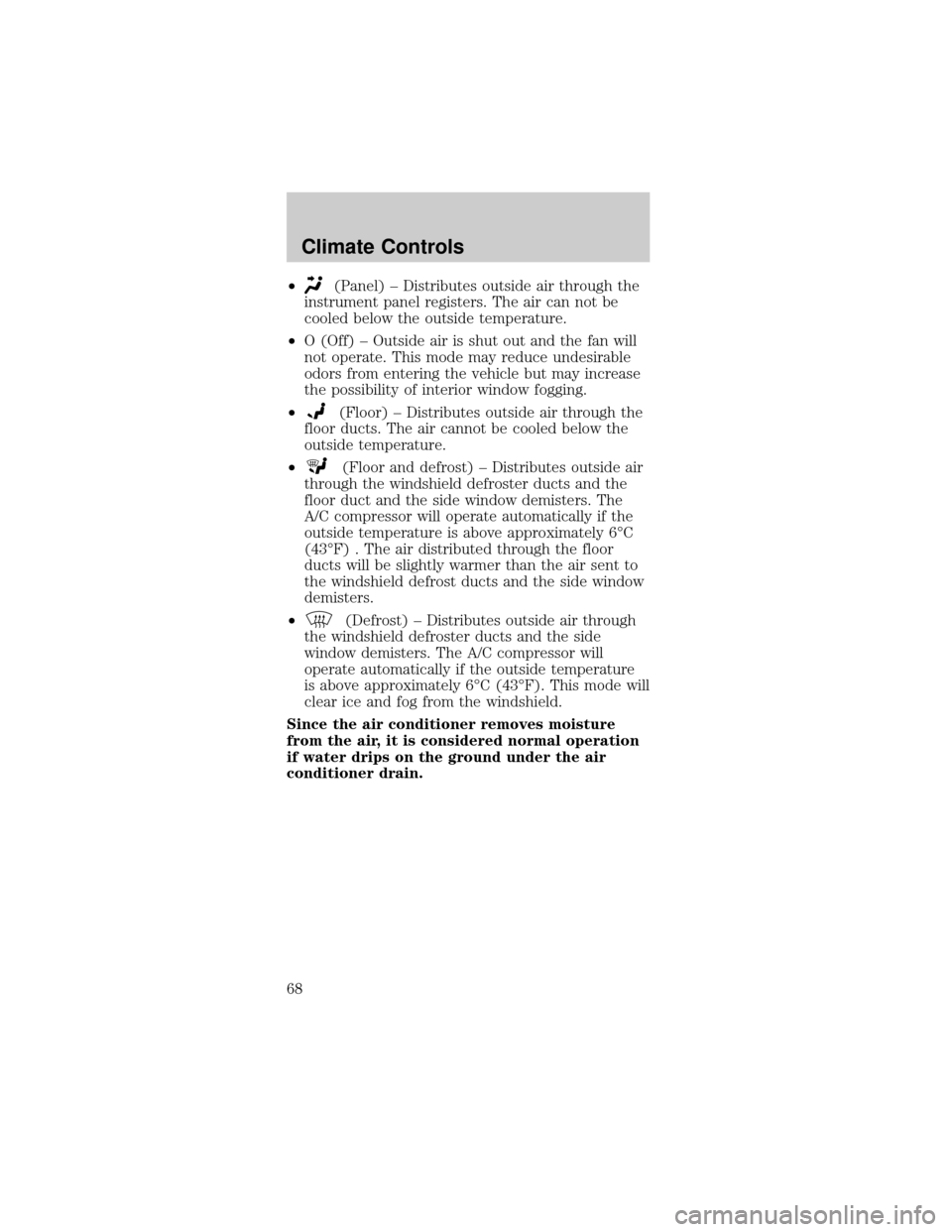Page 15 of 264

Brake system warning
To confirm the brake
system warning light is
functional, it will
momentarily illuminate
when the ignition is turned to the ON position
(alternatively for some vehicles when the ignition is
moved from the ON position to START position, the
light will momentarily illuminate prior to reaching
the START position). It also illuminates if the
parking brake is engaged. If the brake system
warning light does not illuminate as described, seek
service immediately. Illumination after the parking
brake is released indicates low brake fluid level or a
brake system malfunction and the brake system
should be serviced immediately by a qualified
technician. Refer toBrakesin theDrivingchapter
for more information.
Safety belt warning chime
Sounds to remind you to fasten your safety belts.
BeltMinder chime
Sounds intermittently to remind you to fasten your
safety belts.
Supplemental restraint system (SRS) warning
chime
Sounds when a malfunction in the supplemental
restraint system (front or side airbags) has been
detected. Have the supplemental restraint system
inspected immediately.
Key-in-ignition warning chime
Sounds when the key is left in the ignition and the
driver's door is opened.
Headlamps on warning chime
Sounds when the headlamps or parking lamps are
on, the key is removed from the ignition and the
driver's door is opened.
P!
BRAKE
Instrument Cluster
15
Page 18 of 264
Fuel gauge
Displays approximately
how much fuel is in the
fuel tank. The fuel
gauge may vary slightly
when the vehicle is in motion or on a grade.
When refueling the vehicle from empty indication,
the amount of fuel that can be added will be less
than the advertised capacity due to the reserve fuel.
Speedometer
Indicates the current vehicle speed.
²Base instrument
cluster gauge
²Optional instrument
cluster gauge
Odometer
Registers the total
kilometers (miles) of
the vehicle.
F
10 203020 406080100
120
140
160
180
405060 70
80
90
100
11 0
120
FUEL DOOR MPH km/h
102040608020 40608010 012 0 14 0
160
180
200
220
240
100
120
140
305070 90
110
13 0
150
FUEL DOOR MPH km/h
0
00000 00
4
5
6
7
8 3
2
1RPMX1000
SELECT/RESET
.
Instrument Cluster
18
Page 47 of 264
Turn the control to
raise or lower volume.
If the volume is set above a certain level and the
ignition is turned off, the volume will come back on
at a ªnominalº listening level when the ignition
switch is turned back on.
Speed sensitive volume
With this feature, radio volume changes
automatically and slightly with vehicle speed to
compensate for road and wind noise.
The recommended level for speed sensitive volume
is from level 1 through level 3. Level 0 turns the
speed sensitive volume off and level 7 is the
maximum setting.
To engage the speed
sensitive volume
feature, press and hold
the volume control for
five seconds (with the
radio on), then press:
²
to increase
volume
compensation.
²
to decrease or
shut off the volume
compensation.
The selected level will appear in the display.
VOL
PUSH ON
SEL
Entertainment Systems
47
Page 54 of 264

CD select
CD mode may be
entered by pressing
the CD control and the
LOAD control. Load
the CD into the audio system. The first track of the
disc will begin playing. After that, CD play will begin
where it stopped last.
If an alternative CD is desired, press the
corresponding preset control (1±6) of a loaded CD,
or press the TUNE control to access the other
loaded CDs.
NO CD will display if the CD control is activated
when there is not a CD present in the audio system.
NO CD will illuminate in the display if the CD
control and a present number (that is currently
empty) are pressed. The system will play the next
available disc.
If your vehicle is equipped with a CD changer,
pressing the CD control again will allow you to
toggle between accessing the multi disc system and
the CD changer. The display will read CD or CDDJ.
Do not insert any promotional (odd shaped or
sized) discs, or discs with removable labels into
the CD player as jamming may occur.
Display description
Six circles are always lit in the digital display. These
signify the six CD slots in the audio system. When a
disc is loaded into a particular slot (1±6), the
number inside that specific circle lights. If the circle
is empty, there is no CD in that particular slot.
Entertainment Systems
54
Page 64 of 264

sound quality and are recommended only for
speech or low fidelity music material. We
recommend that you encode MP3 files using a
high quality encoder.
²PC configuration Ð Encoding MP3 files requires
intensive use of your computer's resources. Follow
the PC configuration recommendations of the
encoder software vendor. We recommend that you
avoid running other software applications on your
PC during MP3 encoding to avoid undesirable
noise and distortion.
CLEANING COMPACT DISCS
Inspect all discs for contamination before playing. If
necessary, clean discs only with an approved CD
cleaner and wipe from the center out to the edge.
Do not use circular motion.
CD, MP3 AND CD PLAYER CARE
²Handle discs by their edges only. Never touch the
playing surface.
²Do not expose discs to direct sunlight or heat
sources for extended periods of time.
²Do not insert more than one disc into the slot of
the CD player (if equipped).
²Always store discs out of direct sunlight.
Excessive heat may damage or warp discs.
²Use care when handling and playing CD-R and
CD-RW discs, which are more susceptible to
damage from heat, light and stress than are
regular CDs.
²Always insert and remove a disc by holding the
disc flat, with the playing surface facing down, in
order to prevent damage to the disc or the player.
²Never insert any object other than a compact disc
into the player, as doing so may damage the
player and may cause injury to you.
Entertainment Systems
64
Page 65 of 264

²Do not disassemble the player. The laser used in
disc playback is extremely harmful to the eyes.
Do not insert any promotional (odd shaped or
sized) discs, or discs with removable labels into
the CD player as jamming may occur. Damage
incurred by adhesive materials of any kind or
non-standard discs may void the warranty.
CLEANING CASSETTE PLAYER (IF EQUIPPED)
Clean the tape player head with a cassette cleaning
cartridge after 10 to 12 hours of play in order to
maintain the best sound and operation.
CASSETTE AND CASSETTE PLAYER CARE
²Use only cassettes that are 90 minutes long or
less.
²Do not expose tapes to direct sunlight, high
humidity, extreme heat or extreme cold. Allow
tapes that may have been exposed to extreme
temperatures to reach a moderate temperature
before playing.
²Tighten very loose tapes by inserting a finger or
pencil into the hole and turning the hub.
²Remove loose labels before inserting tapes.
²Do not leave tapes in the cassette player for a
long time when not being played.
RADIO FREQUENCY INFORMATION
The Federal Communications Commission (FCC)
and the Canadian Radio and Telecommunications
Commission(CRTC) establish the frequencies AM
and FM stations may use for their broadcasts.
Allowable frequencies are:
AM 530, 540±1600, 1610 kHz
FM 87.7, 87.9±107.7, 107.9 MHz
Not all frequencies are used in a given area.
Entertainment Systems
65
Page 66 of 264

RADIO RECEPTION FACTORS
Three factors can affect radio reception:
²Distance/strength.The further an FM signal
travels, the weaker it is. The listenable range of
the average FM station is approximately 40 km
(24 miles). This range can be affected by ªsignal
modulation.º Signal modulation is a process radio
stations use to increase their strength/volume
relative to other stations.
²Terrain.Hills, mountains and tall buildings
between your vehicle's antenna and the radio
station signal can cause FM reception problems.
Static can be caused on AM stations by power
lines, electric fences, traffic lights and
thunderstorms. Moving away from an interfering
structure (out of its ªshadowº) returns your
reception to normal.
²Station overload.Weak signals are sometimes
captured by stronger signals when you pass a
broadcast tower. A stronger signal may
temporarily overtake a weaker signal and play
while the weak station frequency is displayed.
The audio system automatically switches to single
channel reception if it will improve the reception of
a station normally received in stereo.
AUDIO SYSTEM WARRANTIES AND SERVICE
Refer to theWarranty Guidefor audio system
warranty information.
If service is necessary, see your dealer or a qualified
technician.
Entertainment Systems
66
Page 68 of 264

²(Panel) ± Distributes outside air through the
instrument panel registers. The air can not be
cooled below the outside temperature.
²O (Off) ± Outside air is shut out and the fan will
not operate. This mode may reduce undesirable
odors from entering the vehicle but may increase
the possibility of interior window fogging.
²
(Floor) ± Distributes outside air through the
floor ducts. The air cannot be cooled below the
outside temperature.
²
(Floor and defrost) ± Distributes outside air
through the windshield defroster ducts and the
floor duct and the side window demisters. The
A/C compressor will operate automatically if the
outside temperature is above approximately 6ÉC
(43ÉF) . The air distributed through the floor
ducts will be slightly warmer than the air sent to
the windshield defrost ducts and the side window
demisters.
²
(Defrost) ± Distributes outside air through
the windshield defroster ducts and the side
window demisters. The A/C compressor will
operate automatically if the outside temperature
is above approximately 6ÉC (43ÉF). This mode will
clear ice and fog from the windshield.
Since the air conditioner removes moisture
from the air, it is considered normal operation
if water drips on the ground under the air
conditioner drain.
Climate Controls
68